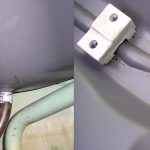Battery – How to replace the battery on a Nissan Figaro Video
Car Batteries like most things, don’t last forever, at some point they do need replacing. A flat, unreliable battery, is always an inconvenience and at times compromises safety and can be positively dangerous.
Often, the reason a car battery fails is because it is simply too old and no longer up to the job it was designed for. If this is the case then unfortunately continuous jump starting or recharging will not solve the problem.
As a guide, the life of a regular car battery is usually somewhere between three and five years when properly cared for, but even this is dependent on several important factors.
Battery Specification
As a club we recommend the Bosch S4 018.
- Fits on existing shelf – Length 187mm x Width 127mm x Height 227mm
- 40 Amps
- 330 Amps CCA (Cold Cranking Amps)
We suggest searching for Bosch S4 018 online you should pay around £50
Why do car batteries go flat?
A battery will lose its charge and become flat if it is not used regularly, or if the car is used for short journeys only when the battery will not have enough time to recharge itself properly. The term for this is ‘under charging’. This leads to a hardening of the lead plates within the battery that affects its ability to hold a charge. This is known as sulphation.
As a car battery works on a chemical reaction basis, the environment temperature and humidity can also play a crucial role in battery performance. A battery operates at maximum efficiency at a temperature of 26.7℃ or 80℉. Higher temperatures speed up internal corrosion within the battery’s cells which reduces the life of the battery. Colder temperatures inhibit a battery’s ability to provide sufficient power to start and run a vehicle.
Leaving an interior light on accidentally can be enough to run your battery flat if left on for long enough.
How to tell if your battery needs replacing
There is a simple test you can carry out to determine the condition of your battery. First, try starting your car at night with the headlights switched on. If the headlights are overly dim, put the vehicle in neutral or park if automatic, and rev the engine. If the battery is failing, the headlights will get brighter as you press the accelerator. A completely flat or dead battery is easy to identify, it simply won’t start at all.
How to fit your battery
1 – Although we recommend that your new battery is fitted in a garage we have listed below a step-by-step guide if you wish to do the job yourself.
2 – First, ensure your Figaro is parked on a flat, level surface – engage the handbrake and remember to keep the keys about your person in case the central locking system activates when the old battery is removed!
3 – For safety reasons, we advise you use protective eyewear and gloves – as car battery acid is highly corrosive and can leak.
4 – Before removing the old battery, ensure you have all of your PIN codes and settings for your car’s electrical systems to hand, such as the satellite navigation system or alarm.
5 – identify the negative and positive connections (the negative is usually coloured black and marked ‘-’ while the positive pole is usually red and signed ‘+’. Label if necessary.
6 – When removing a battery, always remove the negative terminal first as failure to do so could damage your car’s electrical system. Next, loosen the positive terminal, then the clamps or screws securing the battery in its housing
7 – Keep the old battery upright at all times during removal to minimise the risk of acid spillage.
8 – Set the new battery in its housing, making sure the negative and positive posts are in the same position as the battery removed. Check this before tightening the clamps or screws that hold the battery in place. Remove the plastic protective covers from the new battery posts and then securely reconnect the positive (+) terminal followed by the negative (-) terminal.
9 – If you have followed the above steps, you should now be ready to drive away – but do remember to dispose of your old battery at your local recycling centre or scrapyard.
WATCH OUR VIDEO ON HOW TO REMOVE AND FIT

 Subscribe to our Figaro YouTube Channel
Subscribe to our Figaro YouTube Channel
















